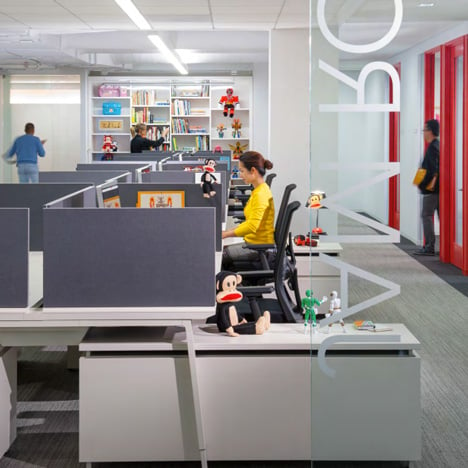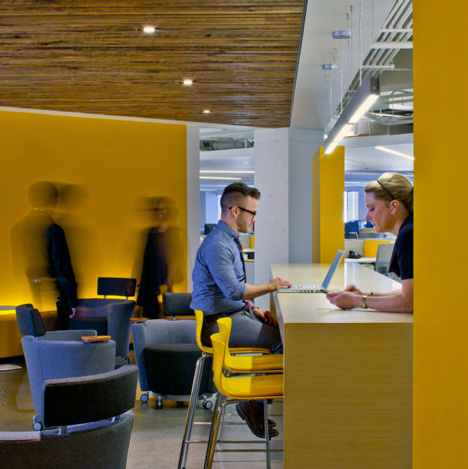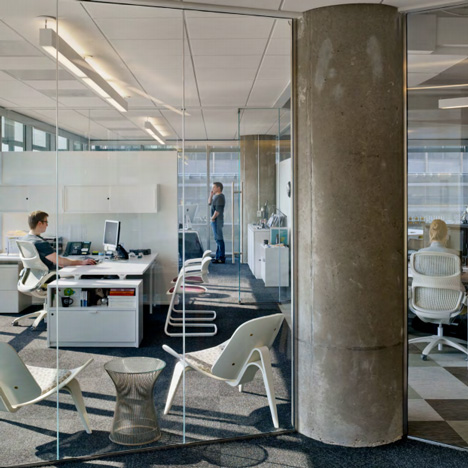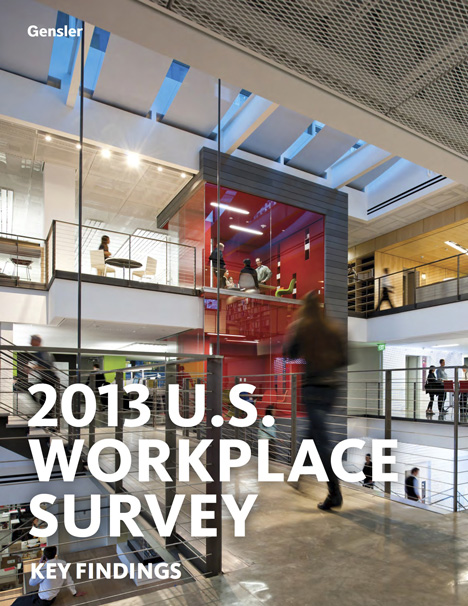
Bad workplace design means most employees are "struggling to work effectively"
News: new office technologies and a move towards collaborative, open-plan offices are leading to declining performance among workers, according to a new workplace design study by architects Gensler.
The 2013 US Workplace Survey found that workplace effectiveness in America has fallen by 6% since 2008, when the firm carried out its first survey.

"Extended workdays, new distractions, and downward pressure on real estate costs are compromising the effectiveness of the U.S. workplace," says the survey. "Strategies to improve collaboration proved ineffective if the ability to focus was not also considered."
Distracting noise and visual stimulus in open-plan offices is one reason for the drop, according to Matthew Kobylar, regional workplace practice area leader at Gensler.
“As you squeeze more people in, the chances of being distracted by noise and visual distractions increases,” Kobylar told Dezeen.
Employers have moved towards open-plan offices over the last ten years to reduce real-estate costs, as they can fit more people into the same amount of space.
Firms have justified this by claiming open-plan offices increase opportunities for collaboration, Kobylar said, but he added: “Cramming people in does have an impact on effectiveness. Just because you can see your colleagues doesn't mean you’re going to collaborate with them.”

To counter this, workplace designers should provide a variety of "secondary" workspaces where workers can concentrate on individual or group tasks, away from distractions - and to prevent them from creating distractions themselves.
“Open plan is quite effective as a general space but there are times when you need to focus on collaboration, and it fails to support that,” Kobylar said.
Quiet areas, spaces or booths for quick meetings and workspaces with views can all help create a balanced, and more effective, office environment, according to Kobylar.
“It allows them to get away from the distraction,” he said. “We’re telling our clients, don’t give up on open plan but acknowledge that people need balance.”

Writing about the reports finding on the company’s blog, Gensler principal Janet Pogue said the research does not mean that open-plan offices don’t work. “Our research shows that effective work can happen in both open and enclosed environments,” she wrote. “Even private offices are not as effective as they were in 2008.”
Instead, the decline in worker effectiveness is down to changing work patterns, including an increase in multitasking and in particular the introduction of always-on technologies such as email, mobile phones and virtual conferencing.
“The world has changed in the last five years, shifting the way we work,” Pogue wrote. “We have more distractions and interruptions, including 24-hour technology demands. Most of us have more on our plates and have to multi-task to get everything done. Collaborating with virtual colleagues takes tremendous concentration and effort. And if effectiveness is declining across the board, open plan offices aren't at fault.”
In their survey, Gensler found that companies that offered a “balanced workplace” with a variety of different workspaces for different tasks outperformed those offering just one option.
“Achieving balance in a workplace is a delicate process,” Pogue explained. “The first priority is to optimize the functionality of primary workspaces. Design elements must mitigate noise and provide access to colleagues while minimizing distractions. It's also important to design a pleasing space where people actually want to be. A balanced workplace also provides a healthy dose of alternative workspaces where groups of one to four people can seamlessly transition from individual work to group work or a person can simply go into an enclosed room and shut the door to concentrate or take a call.”
To compile the report, Gensler surveyed 2,035 "knowledge workers" in firms across the USA. They found that only one in four operate in optimal workplace environments. "The rest are struggling to work effectively, resulting in lost productivity, innovation and worker engagement," the report says.
“Our survey findings demonstrate that focus and collaboration are complementary work modes. One cannot be sacrificed in the workplace without directly impacting the other,” says Diane Hoskins, Gensler co-chief executive officer. “We know that both focus and collaboration are crucial to the success of any organization in today’s economy.”
“Balanced workplaces where employees have the autonomy to choose their work space based on the task or project at hand are more effective and higher performing,” she added.
Kobylar said that as well as increasing pressure on workers, technology could help increase effectiveness if used properly. Tablet computers, smartphones and wifi – technologies that didn’t exist when Gensler carried out there first workplace survey in 2008 – allow staff to move between different work environments according to the tasks they are working on.
“Technology has moved on a lot in the last five years,” he said. “You can be mobile in the office. You can pick up your kit and go.”
Pogue said that employees should create “secondary spaces” where noisy activities such as meetings and conference calls can take place, adding that spaces that allow between two and four people to hold meetings are the most in demand.
“The availability of secondary workspaces is particularly important for creating a balanced workplace,” she wrote “The proximity and availability of secondary work environments can bring balance to a workspace and help occupants work more effectively, both by providing the spaces they need to perform a variety of activities and moving noise and distraction-creating activities away from desks and into more appropriate spaces.”
She concluded: “To really drive performance, companies must create work environments where workers can shift between various work modes and feel comfortable working privately or collaborating with colleagues.”